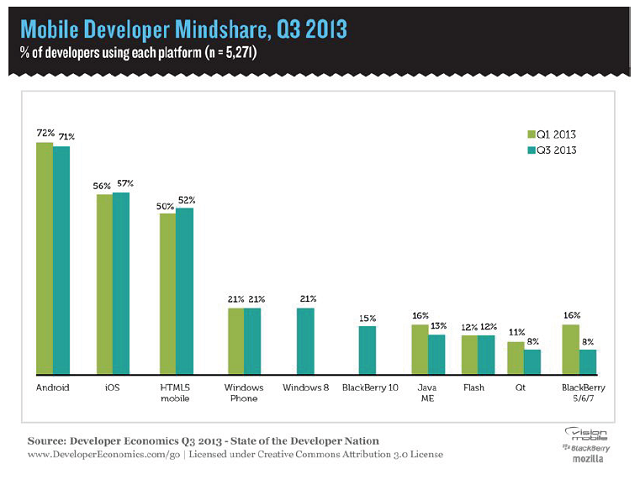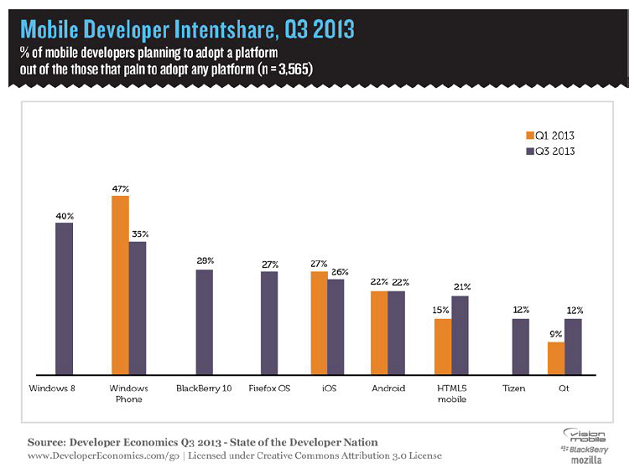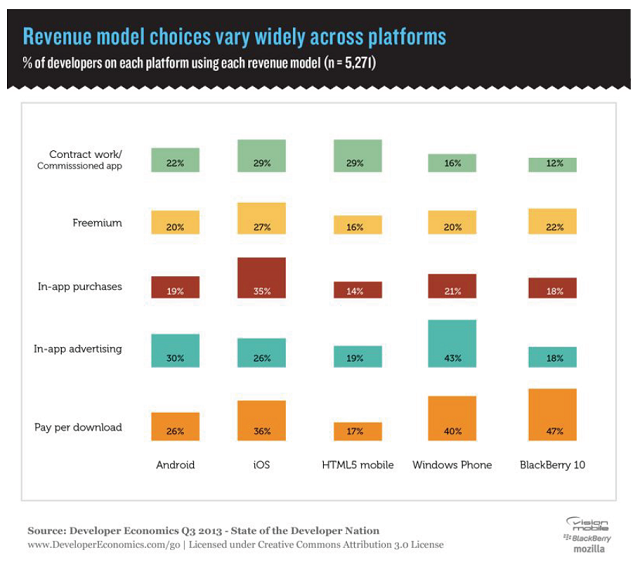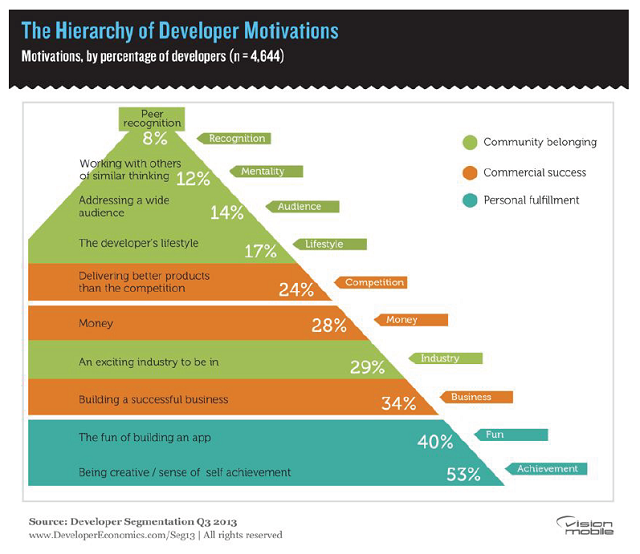New Developer Economics Report Released
Yesterday another Developer Economics report was released - for the third quarter of 2013. The study is based on a survey of more than 6,000 developers. This is the most large-scale study of the market and the economy of mobile development in the world and once again we want to thank everyone who took part in it.

Key facts
')
Developer attention is focused on Android (71%), followed by iOS (57%). HTML5 is the third major application platform, 52% of developers use HTML5 to develop mobile applications.

If we decompose these 52% into components, that 38% of HTML5 developers are engaged in mobile websites, 23% of mobile applications. Hybrid applications, such as those made in PhoneGap, are another 27% of HTML5 development. A smaller part (7%) of developers use the platform to access native APIs via JavaScript, as, for example, in Firefox OS and BlackBerry 10. Another 5% of developers use Javascript-to-native converters, such as Appcelerator.
BlackBerry successfully transferred its old BB developers to the new BB10 platform, it has exactly the same number of developers as BlackBerry 5/6/7 had a year ago.
There is still a strong interest of developers in Windows Phone (35% of developers plan to adopt WP), but it fell by 12 percentage points from the beginning of 2013 - it is obvious that interest has not passed to adoption due to the weak market success of the platform, to that Mobile developers now have a large selection of platforms competing for their attention. Windows 8 is interested in 40%, BlackBerry 10 - 28%, and Firefox OS plans to accept 27% of all developers.

There is no single platform that would unite everyone. The study shows that iOS is more often chosen by those who value potential revenue, graphics, application discovery and user reach. HTML5 developers value cross-platform and development speed / cost. The BlackBerry 10 developers to the community. And Windows Phone interests those who appreciate the development environment and documentation.

Now on average, developers use an average of 2.9 platforms at a time. This is more than the previous figure and the first case of growth since 2011 - in 2011 there were 3.2 platforms, in 2012 - 2.7, in early 2013 - 2.6.
But at the same time, of course, not all platforms are equally valuable for developers. Survey data shows that 84% of mobile developers use iOS, Android, or HTML5 as their main platforms. Most prefer iOS (59%) compared to Android (49%). And despite the fact that Android sells 4 times as many devices, despite the fact that the attention of developers to Android is much more - the platform is behind iOS by the number of developers for whom this OS is the main one. The priority of the platforms also depends on experience. Newbies are more interested in Android - 40% of novice mobile developers prefer Android and only 20% of iOS.
On average, on iOS, a developer earns $ 5,200 - this is the most profitable platform, Android is 10% behind ($ 4,700). On the third - Windows Phone ($ 3,600).
As before, developers do not have a dominant way of getting money on all platforms - on Windows Phone, developers expressly prefer advertising and pay per download, on BlackBerry 10 pay per download. On Android, iOS, and HTML5, there are no such pronounced preferences in income generation models.

But contrary to popular belief, money is not the only incentive for mobile application developers. Money, in one form or another, is the goal for only 50% of developers. For more people (53%) this is creativity and achievement. For a little less (40%) it’s just fun.

Download the report for free here: http://www.developereconomics.com/reports/q3-2013/

Key facts
')
Developer attention is focused on Android (71%), followed by iOS (57%). HTML5 is the third major application platform, 52% of developers use HTML5 to develop mobile applications.

If we decompose these 52% into components, that 38% of HTML5 developers are engaged in mobile websites, 23% of mobile applications. Hybrid applications, such as those made in PhoneGap, are another 27% of HTML5 development. A smaller part (7%) of developers use the platform to access native APIs via JavaScript, as, for example, in Firefox OS and BlackBerry 10. Another 5% of developers use Javascript-to-native converters, such as Appcelerator.
BlackBerry successfully transferred its old BB developers to the new BB10 platform, it has exactly the same number of developers as BlackBerry 5/6/7 had a year ago.
There is still a strong interest of developers in Windows Phone (35% of developers plan to adopt WP), but it fell by 12 percentage points from the beginning of 2013 - it is obvious that interest has not passed to adoption due to the weak market success of the platform, to that Mobile developers now have a large selection of platforms competing for their attention. Windows 8 is interested in 40%, BlackBerry 10 - 28%, and Firefox OS plans to accept 27% of all developers.

There is no single platform that would unite everyone. The study shows that iOS is more often chosen by those who value potential revenue, graphics, application discovery and user reach. HTML5 developers value cross-platform and development speed / cost. The BlackBerry 10 developers to the community. And Windows Phone interests those who appreciate the development environment and documentation.

Now on average, developers use an average of 2.9 platforms at a time. This is more than the previous figure and the first case of growth since 2011 - in 2011 there were 3.2 platforms, in 2012 - 2.7, in early 2013 - 2.6.
But at the same time, of course, not all platforms are equally valuable for developers. Survey data shows that 84% of mobile developers use iOS, Android, or HTML5 as their main platforms. Most prefer iOS (59%) compared to Android (49%). And despite the fact that Android sells 4 times as many devices, despite the fact that the attention of developers to Android is much more - the platform is behind iOS by the number of developers for whom this OS is the main one. The priority of the platforms also depends on experience. Newbies are more interested in Android - 40% of novice mobile developers prefer Android and only 20% of iOS.
On average, on iOS, a developer earns $ 5,200 - this is the most profitable platform, Android is 10% behind ($ 4,700). On the third - Windows Phone ($ 3,600).
As before, developers do not have a dominant way of getting money on all platforms - on Windows Phone, developers expressly prefer advertising and pay per download, on BlackBerry 10 pay per download. On Android, iOS, and HTML5, there are no such pronounced preferences in income generation models.

But contrary to popular belief, money is not the only incentive for mobile application developers. Money, in one form or another, is the goal for only 50% of developers. For more people (53%) this is creativity and achievement. For a little less (40%) it’s just fun.

Download the report for free here: http://www.developereconomics.com/reports/q3-2013/
Source: https://habr.com/ru/post/187020/
All Articles